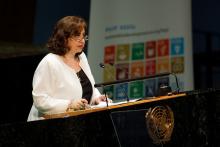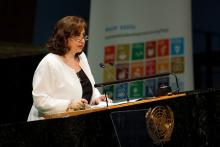The thematic review of SDG5 was clear. We have to do things differently.
We have to scale up investment in gender equality. We must promote and support women’s health, education, and leadership. We must ensure that women are able to access financing and resources.
Forty-four countries have or will be presenting their voluntary national reviews by the time this forum concludes. Eleven for the first time.
We salute this effort to take stock of what has been done, and what must still be done.
Your Excellencies,
Time is running out. We have only eight years left until 2030. And we have heard that we are very much off track.
A devasting pandemic has affected every region of the world—every country, every woman, every girl—and has deepened inequalities.
And even as we work to recover from it, we continue to leave people, women and girls, and countries behind.
This is also evident in our solution to end the pandemic, namely access to services and vaccines.
In 2021, WHO set a target for 70-per-cent global COVID-19 vaccination coverage by mid-2022. As of last month, only 58 of WHO’s 194 Member States had reached that 70-per-cent target.
In low-income countries, just 37 per cent of healthcare workers had received a complete course of primary COVID vaccination.
This too, has a gendered impact, as 70 per cent of frontline healthcare workers, globally, are women.
We face wars, crises, humanitarian emergencies, food, energy and finance insecurities, inflation, and unsustainable debt. We see the severe impacts of climate change, with biodiversity loss and rising pollution driving flooding and drought, and more crises.
Peace, security, prosperity, and a life free from violence are far from the reality of most people, and in particular for women and girls.
These crises compound the pre-existing gender poverty gap. No matter where in the world, it is women and girls who bear the brunt of job losses and plummeting economic security.
It is women and girls who navigate the strain of diminished public services.
It is women and girls who faced increased domestic violence, at the levels of a shadow pandemic, as a result of COVID-19.
There is no corner in the world where violence against women and girls does not exist.
Two hundred and forty-five million women and girls have been subjected to physical or sexual violence by an intimate partner.
Across the world, gender-based violence hotlines saw an increase in calls during the COVID-19 pandemic, as women and girls were locked down with their abusers, and services became inaccessible.
Excellencies,
If we were in any doubt, this past week has driven home the message that we must redouble our efforts—if history is not to judge Agenda 2030 as evidence of our unwillingness to deliver on the promises we made to those who need our collective efforts the most.
The good news is that we have solutions. All through this week we have heard about what needs to be done. It simply requires that we do it. It simply requires that we all do it.
I ask that we acknowledge the centrality of gender equality to those solutions. We know that SDG 5 is not just a goal in its own right. It is the key and the bedrock to the SDGs as a whole.
Excellencies,
This year, you have reviewed in-depth progress on the implementation of SDG 5. Many of you have presented impressive results on the advancement of SDG 5 in your countries. From an increase of women in the workforce, to new legislations to combat violence against women.
We remain hopeful by these achievements.
But a review of progress by UN Women and the UN Statistical Division reveals that, globally, only one indicator under SDG 5 is “close to target”.
This one indicator is the proportion of seats held by women in local government. I applaud this.
Yet, in all other areas, including equality in time spent on unpaid care and domestic work, decision-making regarding sexual and reproductive health, and effective policies on gender equality and women’s empowerment, the world is “far from target”.
Data gaps continue to hinder our ability to successfully monitor all the SDGs. For example, there are several SDG 5 indicators for which the world has inadequate data to assess progress, the most pervasive being the indicator tracking women’s secure rights over land.
Excellencies,
The distance to achieving SDG 5 is far, and time is short.
Bold, evidence-based actions and increased financing are needed for a whole-of-society effort to address the needs and rights of all women and girls.
As we have heard from the Secretary-General time and time again, we need renewed multilateralism and a reinvigorated commitment to the Sustainable Development Goals.
The COVID-19 pandemic was a stark reminder that we are interconnected and so are our solutions; that our future depends on everyone prospering, and, indeed, that no one is left behind.
We know that this can happen. We saw it a few months ago during the 66th session of the Commission on the Status of Women. For the first time, Member States negotiated agreed conclusions that recognized women’s critical role in finding climate solutions.
The negotiations were tough and long but showed the very best of our multilateral system and of the criticality of working together to collectively advance the rights of women and girls everywhere for a more sustainable common future. We look to CSW to continue on this path.
Your Excellencies,
We know the solution. We have heard it presented here over the past week. We see it in every resolution passed on women’s leadership.
We identified it in Goal 5. It is simple: increased gender equality results in more sustainable and peaceful societies.
COVID-19 was a clear lesson in the power of gender equality.
UN Women and the United Nations Development Programme UNDP assessed close to 5,000 policy measures adopted by 226 countries and territories in response to COVID-19.
The assessment showed that, while women and girls have been on the frontlines of the pandemic response, they have been given a back seat in shaping recovery and remain underrepresented in decision-making processes.
But we also found that countries with robust public services and gender-responsive social protection systems were in a better position to respond to the pandemic.
And countries mounted a more effective response when they had more women in leadership, in parliaments and in ministries.
Just as we know that peace agreements are more likely to last when women are meaningfully involved, social policies are more likely to be effective when leadership is balanced.
To conclude, I have five asks to get ourselves back on track to Agenda 2030.
First, let us increase investments in gender-responsive social protection and public services to increase resilience to future shocks.
Second, let us strengthen institutional capacity, increase women’s leadership, and recognize the voice and agency of all women and girls in shaping their future.
Third, let us ensure that there is adequate financing for gender equality, including through prioritizing gender equality both in national budgets and in official development assistance.
Fourth, let us ensure that we have a robust evidence base and access to data. It is not acceptable that, halfway through our Agenda, we still have areas where data are lacking to provide a proper picture of progress.
Fifth, let us recognize and embrace the important role and contributions of civil society and women’s organizations, of women human rights and environmental defenders, and of the young women and men around the world.
More space for them in decision-making processes will translate to transformative change in our communities and societies and will accelerate our path to recovery and resilience.
Excellencies,
I assure you again that UN Women will continue to work alongside you. We will continue to strengthen our partnerships at national level, supporting all Member States who request it, with gender expertise and the power of our mandate and voice.
The 2030 Sustainable Development Agenda remains the world’s best roadmap to peace, security, recovery, dignity, and shared prosperity.
We are all too aware that we are far off track, but equally sure of the power of multilateralism and our collective action and solidarity.
I remind us all that our ability to fulfil the promises we made in the 2030 Agenda depends in large part on our collective decision to put women and girls at the centre of all actions.
Only then can we lay the foundations for a more sustainable, resilient and gender-just future for all.
I wish you all every success and I thank you.

